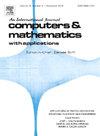求解拉普拉斯方程和双调和方程反柯西问题的基本解神经网络
IF 2.5
2区 数学
Q1 MATHEMATICS, APPLIED
引用次数: 0
摘要
本文提出了一种求解反柯西问题的基本解神经网络方法(FSNNs),该方法将基本解方法与物理信息神经网络(PINNs)相结合。为了优化源点的分布,该方法首先将区间划分为相等的段,由源点的数量决定。坐标系位于计算域的中心。产生的角度作为fsnn的网络输入,中间变量作为输出,随后将其替换为长度函数以获得最终长度。然后确定源点的坐标,并使用MFS来逼近数值解。在可达边界上根据边界条件构造损失函数,并利用训练结果对fsnn中的网络参数和MFS中的源点强度进行优化。pinn的引入克服了MFS中源点选择的挑战,有效地解决了逆问题的病态性。综上所述,该方案是一种基于机器学习的半解析无网格方法,具有简单、准确、易于实现的特点,非常适合于反问题的数值求解。包括拉普拉斯方程和双谐波方程在内的四个数值实验验证了所提出的fsnn的有效性和准确性。本文章由计算机程序翻译,如有差异,请以英文原文为准。
Fundamental solution neural networks for solving inverse Cauchy problems for the Laplace and biharmonic equations
This paper proposes a novel fundamental solution neural networks method (FSNNs) to solve inverse Cauchy problems, which combines the method of fundamental solutions (MFS) with the physics-informed neural networks (PINNs). To optimize the distribution of source points, the method starts by partitioning the interval into equal segments, determined by the number of the source points. The coordinate system is situated at the center of the computational domain. The resulting angles as network inputs for the FSNNs and the intermediate variable as outputs, which is subsequently substituted into a length function to obtain the final length. The coordinates of the source points are then determined, and the MFS is employed to approximate the numerical solutions. The loss function is formulated based on the boundary conditions on the accessible boundary, and the training is employed to optimize the network parameters in the FSNNs and source point intensities in the MFS. The introduction of the PINNs overcomes the challenge of source point selection in the MFS and effectively addresses the ill-posedness of inverse problems. In summary, the proposed scheme is a machine learning-based semi-analytical meshless method which is simple, accurate and easily implemented, making it highly suitable for the numerical solution of inverse problems. Four numerical experiments, including the Laplace and biharmonic equations, validate the effectiveness and accuracy of the proposed FSNNs.
求助全文
通过发布文献求助,成功后即可免费获取论文全文。
去求助
来源期刊

Computers & Mathematics with Applications
工程技术-计算机:跨学科应用
CiteScore
5.10
自引率
10.30%
发文量
396
审稿时长
9.9 weeks
期刊介绍:
Computers & Mathematics with Applications provides a medium of exchange for those engaged in fields contributing to building successful simulations for science and engineering using Partial Differential Equations (PDEs).
 求助内容:
求助内容: 应助结果提醒方式:
应助结果提醒方式:


